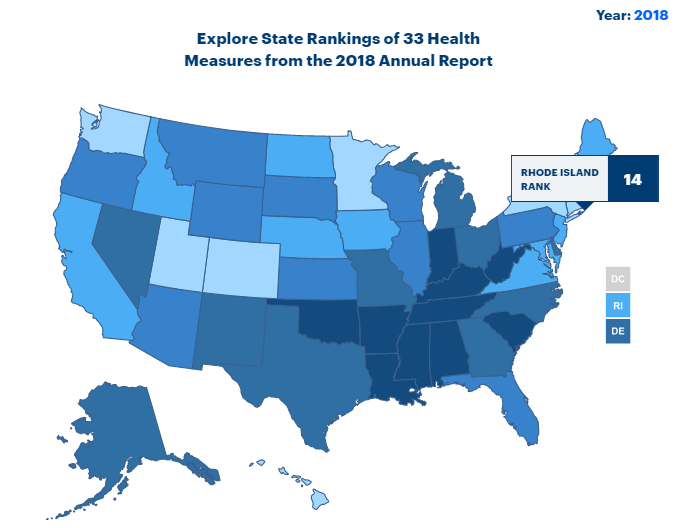
PROVIDENCE — Rhode Island ranks first in the United States for its number of primary care physicians per 100,000 people in the 29th America’s Health Rankings Annual Report released by the United Health Foundation Thursday, as well as first for adolescent female and male HPV vaccination rates as a percentage of 13- to 17-year-olds.
The state ranked No. 14 overall in the country in the annual assessment, falling three spots since 2017, when it ranked No. 11 in the U.S. This year the Ocean State ranked No. 8 for overall senior health and ninth for the health of women and children.
“There are some areas where Rhode Island is doing particularly well,” said Dr. Rhonda Randall, chief medical officer of UnitedHealthcare National Markets, and an adviser to America’s Health Rankings.
The number of primary care physicians increased 5 percent nationwide in the past year, according to the report. In Rhode Island, the number of primary care physicians increased 3 percent from 256 to 264 per 100,000 people, the report states, the most among the 50 states.
Randall noted increasing the number of primary care physicians in a state and the country in general is important, given the national shortage in effect. She said having access to primary care doctors improves your ability to get an appointment and access to care.
Randall said the increase in the U.S. and R.I. were heartening in light of the shortage.
“It’s been concerning us,” she said.
Randall noted another high mark for the state in the report’s policy category, which gave Rhode Island high marks for effective immunization, access to insurance and public health funding, leading to an overall No. 2 rank for health care policy.
Rhode Island’s rate of adolescent immunization against human papillomavirus, the most common sexually transmitted infection in the United States, according to the Centers for Disease Control and Prevention, was noteworthy, Randall said, as were immunizations against other diseases:
- Adolescent female HPV immunization was at 78 percent aged 13 to 17, ranking No. 1 in the U.S.
- Adolescent male HPV immunization was at 78.4 percent aged 13 to 17, ranking No. 1 in the U.S.
- Overall adolescent meningococcal immunization was at 94.1 percent aged 13 to 17; ranking No. 3 in the U.S.
- Overall adolescent Tdap immunization was at 94.6 percent aged 13 to 17; ranking No. 5 in the U.S.
- Overall immunization of children was at 74.4 percent of those aged 19 to 35 months; ranking No. 14 in the U.S.
Public health funding was $143 per person, ranking seventh in the U.S., and the percentage of uninsured in the state was 4.5 percent, ranking No. 5 in the U.S.
In Rhode Island, additional strengths included a low rate of diabetes at 8.9 percent of adults, No. 9 in the U.S., and 395.4 mental health providers per 100,000 people, ranking No. 5 in the U.S.
Challenges in R.I. included a high rate of drug-related deaths and mental distress, according to the report.
The state ranks No. 45 in the country in drug deaths, measured at deaths per 100,000 population. This issue is not unique among New England’s states. New Hampshire ranked No. 49, Massachusetts ranked No. 43, Connecticut ranked No. 39, and Maine ranked No. 37.
Rhode Island also ranked No. 41 in the country in its percentage of adults who experience “frequent mental distress,” at 14.6 percent of adults.
Premature deaths also increased nationally 3 percent (from 7,214 to 7,432 years lost before 75 per 100,000 people). Rhode Island’s total was lower than the national average at 6,561 years lost before 75 per 100,000 people, ranking No. 22 in the country, according to the report.
Childhood poverty, a key indicator of socioeconomic status and overall health, decreased 19 percent nationwide in the past five years from 22.6 percent in 2013 to 18.4 percent in 2018. Rhode Island’s childhood poverty rate was 16 percent, ranking No. 24 in the country. The figure was slightly higher than in 2017, when the state’s childhood poverty rate was 15.6 percent.
The national obesity rate exceeded 30 percent of the adult population for the first time in America’s Health Rankings history, an increase of 5 percent in the past year (from 29.9 percent to 31.3 percent). Rhode Island’s obesity rate was a bit below the national average at 30 percent, ranking No. 22 overall.
“This year’s Annual Report spotlights an obesity problem that continues to grow. This means more people will likely develop obesity-related chronic diseases like cardiovascular disease, diabetes and cancer,” said Randall. “We encourage health professionals, public health officials and elected leaders to use these findings to explore opportunities to better support people in their communities in all aspects of their health.”
Rob Borkowski is a PBN staff writer. He can be reached at Borkowski@PBN.com.












